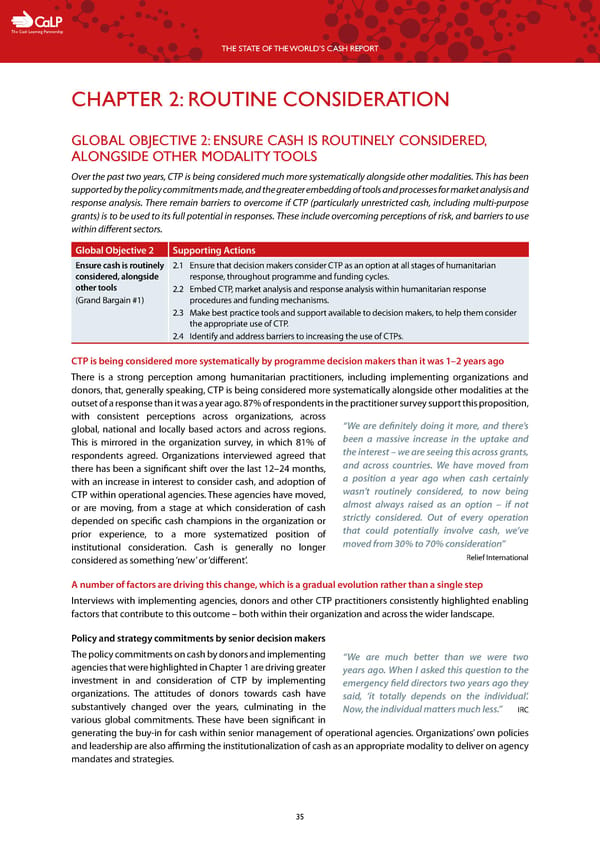C The Cash Learning Partnership THE STATE OF THE WORLD’S CASH REPORT CHAPTER 2: ROUTINE CONSIDERATION GLOBAL OBJECTIVE 2: ENSURE CASH IS ROUTINELY CONSIDERED, ALONGSIDE OTHER MODALITY TOOLS Over the past two years, CTP is being considered much more systematically alongside other modalities. This has been supported by the policy commitments made, and the greater embedding of tools and processes for market analysis and response analysis. There remain barriers to overcome if CTP (particularly unrestricted cash, including multi-purpose grants) is to be used to its full potential in responses. These include overcoming perceptions of risk, and barriers to use within different sectors. Global Objective 2 Supporting Actions Ensure cash is routinely 2.1 Ensure that decision makers consider CTP as an option at all stages of humanitarian considered, alongside response, throughout programme and funding cycles. other tools 2.2 Embed CTP, market analysis and response analysis within humanitarian response (Grand Bargain #1) procedures and funding mechanisms. 2.3 Make best practice tools and support available to decision makers, to help them consider the appropriate use of CTP. 2.4 Identify and address barriers to increasing the use of CTPs. CTP is being considered more systematically by programme decision makers than it was 1–2 years ago There is a strong perception among humanitarian practitioners, including implementing organizations and donors, that, generally speaking, CTP is being considered more systematically alongside other modalities at the outset of a response than it was a year ago. 87% of respondents in the practitioner survey support this proposition, with consistent perceptions across organizations, across global, national and locally based actors and across regions. “We are definitely doing it more, and there’s This is mirrored in the organization survey, in which 81% of been a massive increase in the uptake and respondents agreed. Organizations interviewed agreed that the interest – we are seeing this across grants, there has been a significant shift over the last 12–24 months, and across countries. We have moved from with an increase in interest to consider cash, and adoption of a position a year ago when cash certainly CTP within operational agencies. These agencies have moved, wasn’t routinely considered, to now being or are moving, from a stage at which consideration of cash almost always raised as an option – if not depended on specific cash champions in the organization or strictly considered. Out of every operation prior experience, to a more systematized position of that could potentially involve cash, we’ve institutional consideration. Cash is generally no longer moved from 30% to 70% consideration” considered as something ‘new’ or ‘different’. Relief International A number of factors are driving this change, which is a gradual evolution rather than a single step Interviews with implementing agencies, donors and other CTP practitioners consistently highlighted enabling factors that contribute to this outcome – both within their organization and across the wider landscape. Policy and strategy commitments by senior decision makers The policy commitments on cash by donors and implementing “We are much better than we were two agencies that were highlighted in Chapter 1 are driving greater years ago. When I asked this question to the investment in and consideration of CTP by implementing emergency field directors two years ago they organizations. The attitudes of donors towards cash have said, ‘it totally depends on the individual’. substantively changed over the years, culminating in the Now, the individual matters much less.” IRC various global commitments. These have been significant in generating the buy-in for cash within senior management of operational agencies. Organizations’ own policies and leadership are also affirming the institutionalization of cash as an appropriate modality to deliver on agency mandates and strategies. 35
 The State of the World's Cash | Full Report Page 36 Page 38
The State of the World's Cash | Full Report Page 36 Page 38